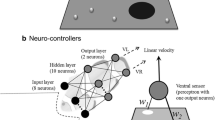Abstract
We describe a new point of view that uses contextual information of the interrelated conditions in which criminality or deviant occurs by means of computer simulation to examine its role in a progressively changing society. Based on the functionalist point of view, we model society as a multi agent system and criminality as a noise. A noise is injected as training signals to the single layer perceptrons that functions as agents (i.e. society) and all agents must comply the fitness function. Failure to comply will result in the agent being removed from the “society” and be replaced by a “newborn” that inherits some “upbringing” information from its “mother’s agent”. Our simulation studies point toward the constructive effects of criminality. The major contribution in our study is that new paradigm can show and measure criminality effects as in contrast to mere verbal descriptions of the social sciences. The new paradigm could be used to provide the functional explanation of atypical trends in criminality in East- and Middle European and some other countries and provide “artificial experimental data” for future studies.
Preview
Unable to display preview. Download preview PDF.
Similar content being viewed by others
References
Hazans, M.: How parallel markets fuelled chronic shortage in Soviet official sector. Baltic Journal of Economics 1(2), 3–58 (1999)
Pumputis, A.: About Needs and Systems of Human Rights. Jurisprudencija. Mykolas Romeris Univ. Publ. Vilnius 15(7), 61–65 (2000)
Cohen, L., Felson, M.: Social change and crime rate trends: A routine activity approach. American Sociological Review 44, 588–608 (1986)
Parsons, T.: Societies: Evolutionary and Comparative Perspectives. Free Press, NY (1966)
Justickis, V.: Criminology, vol. 1. Law University of Lithuania Publ., Vilnius (2001)
Raudys, S.: Survival of intelligent agents in changing environments. In: Rutkowski, L., Siekmann, J.H., Tadeusiewicz, R., Zadeh, L.A. (eds.) ICAISC 2004. LNCS (LNAI), vol. 3070, pp. 109–117. Springer, Heidelberg (2004)
Henricksen, K., Indulska, J., Rakotonirainy, A.: Modeling context information in pervasivecomputing systems. In: Mattern, F., Naghshineh, M. (eds.) PERVASIVE 2002. LNCS, vol. 2414, pp. 167–180. Springer, Heidelberg (2002)
United Nations. National Accounts, Statistics: Analysis of main aggregates and detailed tables, 2000. United Nations Publ., New York (2002)
Etorf, H., Spengler, H.: Crime in Europe. Causes and Consequences. Springer, New York (2002)
Crime and Criminal Justice in Europe and North America 1995-1997. Report on the Sixth United Nations Survey on Crime Trends and Criminal Justice Systems. In: Aromaa, K., Leppä, S., Nevala, S., Ollus, N. (eds.) European Institute for Crime Prevention and Control, affiliated with the United Nations, HEUNI, Helsinki (2003)
Criminal Victimization in eleven Industrialized Countries. Key findings from the, International Crime Victims Survey. The Hague: Ministry of Justice, WODC (1996)
Haykin, S.: Neural Networks: A comprehensive foundation, 2nd edn. Prentice-Hall, Englewood Cliffs (1999)
Raudys, S.: On the universality of the single-layer perceptron model. Neural Networks and Soft Computing. In: Rutkowski, L. (ed.) Neural Networks and Soft Computing, pp. 79–86. Physica-Verlag (Springer), New York
Raudys, S.: An adaptation model for simulation of aging process. Int. J. Modern Physics C 13(8), 1075–1086 (2002)
Raudys, S., Justickis, V.: Yerkes-Dodson law in agents training. In: Pires, F.M., Abreu, S.P. (eds.) EPIA 2003. LNCS (LNAI), vol. 2902, pp. 54–58. Springer, Heidelberg (2003)
Fukunaga, K.: Introduction to Statistical Pattern Recognition, 2nd edn. Academic Press, New York (1990)
Raudys, S.: Statistical and Neural Classifiers: An integrated approach to design. Springer, NY (2001)
Skurichina, M., Raudys, S., Duin, R.P.W.: K-nearest neighbors directed noise injection in multilayer perceptron training. IEEE Trans. on Neural Networks 11, 504–511 (2000)
Author information
Authors and Affiliations
Editor information
Editors and Affiliations
Rights and permissions
Copyright information
© 2005 Springer-Verlag Berlin Heidelberg
About this paper
Cite this paper
Raudys, S., Hussain, A., Justickis, V., Pumputis, A., Augustinaitis, A. (2005). Functional Model of Criminality: Simulation Study. In: Dey, A., Kokinov, B., Leake, D., Turner, R. (eds) Modeling and Using Context. CONTEXT 2005. Lecture Notes in Computer Science(), vol 3554. Springer, Berlin, Heidelberg. https://doi.org/10.1007/11508373_31
Download citation
DOI: https://doi.org/10.1007/11508373_31
Publisher Name: Springer, Berlin, Heidelberg
Print ISBN: 978-3-540-26924-3
Online ISBN: 978-3-540-31890-3
eBook Packages: Computer ScienceComputer Science (R0)




